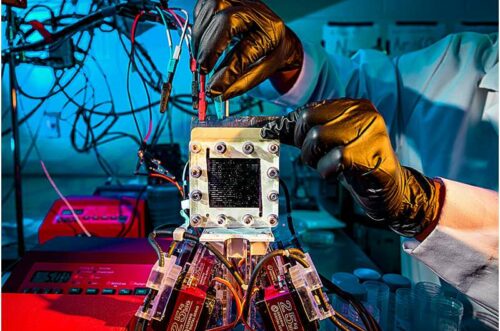A new design for seawater desalination uses tapered channels to boost efficiency, cut energy use, and challenge current methods. Could this change water technology?

Engineers at the University of Illinois at Urbana-Champaign have developed a method to address the “dead zones” in fluid flow commonly encountered in the electrodes of batteries used for seawater desalination. This innovative approach employs a physics-inspired tapered flow channel design within the electrodes, enabling fluids to move more swiftly and efficiently.
This technique could use less energy than the currently dominant reverse osmosis methods.
While desalination technology offers a solution to water scarcity, its widespread adoption has been hindered by technical challenges. The predominant technique, reverse osmosis, involves forcing water through a membrane to remove salt, which is both costly and energy-demanding.
In contrast, the battery-based method uses electricity to extract charged salt ions from the water. However, this approach also consumes energy to propel water through electrodes with small, irregularly shaped pores.
The research group at Illinois has spent years developing a battery-based desalination technique, incorporating extensive modelling and experiments. Their efforts have recently led to a breakthrough study that introduced electrodes with tiny microchannels known as interdigitated flow fields (IDFFs).
Their latest research advances this concept by employing tapered channels within the electrodes rather than straight ones. This modification has enhanced fluid flow—or permeability—by two to three times compared to consecutive channels. The results of this study have been published in the journal Electrochimica Acta.
During their experiments, the researchers encountered manufacturing challenges, notably, the lengthy process required to mill channels into the electrodes, a significant hurdle for scaling up production. Despite this, Smith expressed confidence that this obstacle can be surmounted.
The channel-tapering theory and design principles apply to various electrochemical devices that use flowing fluids. Beyond their role in electrochemical desalination, they can be utilized in energy storage, conversion, and environmental sustainability devices, including fuel cells, electrolysis cells, flow batteries, carbon capture systems, and lithium recovery systems.
Reference: Md Habibur Rahman et al, Tapered, Interdigitated Channels for Uniform, Low-Pressure Flow through Porous Electrodes for Desalination and Beyond, Electrochimica Acta (2025). DOI: 10.1016/j.electacta.2024.145632






